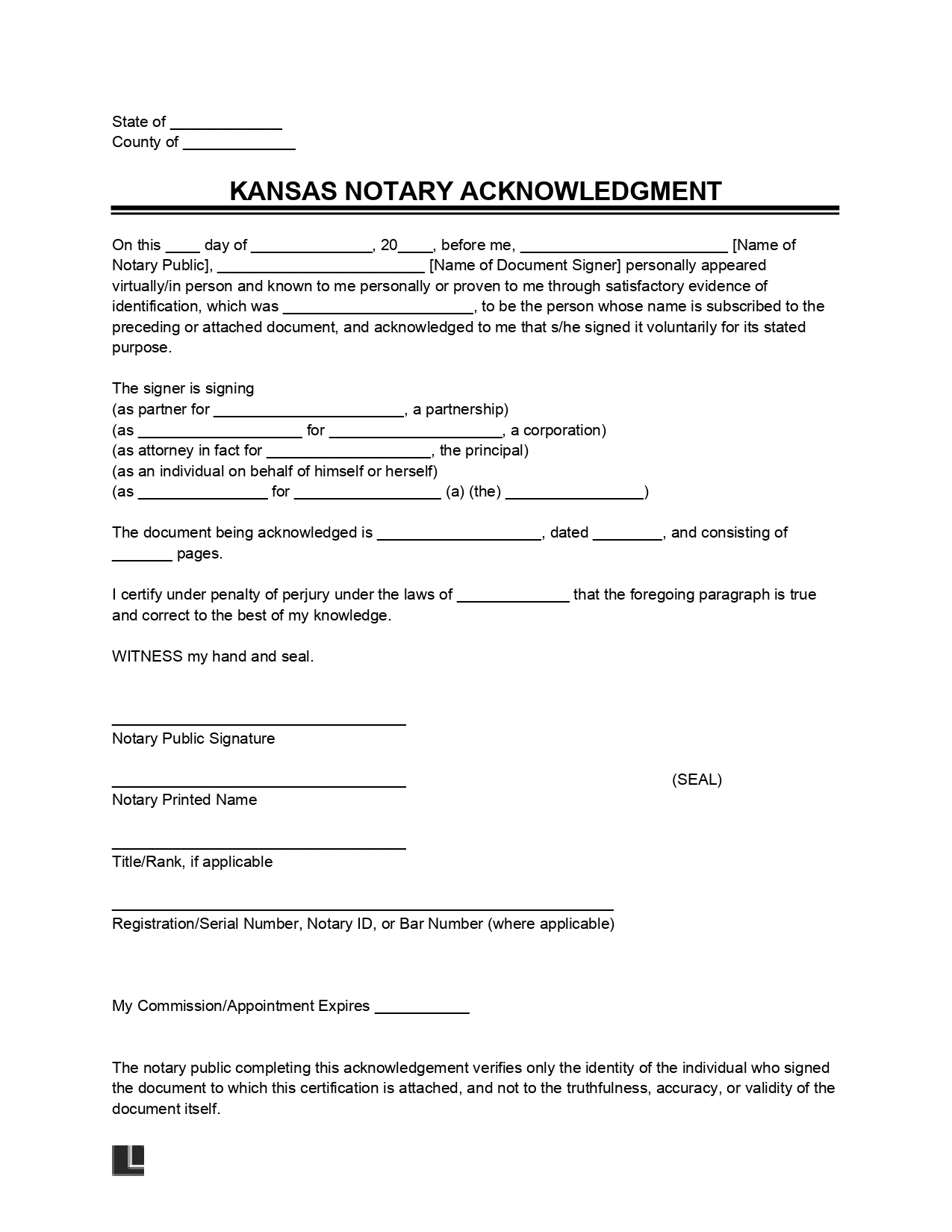A Kansas notary acknowledgment is a document that serves as written proof that a document has been notarized. This declaration is made by each individual who signs the document, certifying the authenticity of their signatures.
The notary public verifies the signers’ identities and ensures that each signer acknowledges they have inscribed the signature of their own free will. Once completed and signed by the notary, the form is attached to the document, legal or otherwise, to prove the authenticity of the signatures.
Legal Considerations
Statute: § 53-509
Form of Acknowledgment: Must be evidenced by a certificate that meets certain requirements and is signed and dated by a notarial officer certifying that the officer has made the determinations required by § 53-503. (§ 53-508)
Notary Term of Commission: Four years. (§ 53-5a22)
Notary Handbook: The Notary Handbook provides guidelines and instructions for notaries public to perform their duties by the laws and regulations of the state.
Is Online Notarization Legal in Kansas?
Yes, online notarization is legal. As per § 53-5a15, the state allows notaries to perform notarial acts using communication technology for a remotely located individual under certain conditions, including identity verification and audio-visual recording, with a short-form certificate indicating that the act was performed using communication technology.
How to Notarize
Step 1 – Locate a Notary Public
You can find a notary public by visiting a bank or credit union, a UPS store, or a private notary service. Capitol Federal has the most branches throughout the state.
Step 2 – Prepare the Document
If the document needs an acknowledgment, ensure all signature fields are left blank.
Step 3 – Present Identification
When you meet with the notary public, you must present identification. Each signing party must have their identification verified unless the notary public recognizes one of the signers personally.
Step 4 – Sign the Document
Sign the document in front of the notary. If the document requires an acknowledgment, the signatures can be included, but each signer must declare that they signed absent coercion.
Step 5 – Take an Oath
Some notarial acts, such as jurats, require that signers take an oath or affirmation certifying the truthfulness of the document’s contents.
Step 6 – Get the Document Notarized
The notary public will sign and stamp the notarial certificate, at which point the document is considered notarized. Remember that the document signer must appear in person before a notary public, who will verify their identity, ensure that they are signing the document of their own free will, and complete the notary acknowledgment section of the document, as well as a notary journal entry for the notarization.
How to Verify a Notary
- Go to the Kansas Secretary of State Notary Search page.
- You can search for a notary public by name, commission number, or city on the “Search for a Notary Public” page. Enter the required information in the search fields and click “Search.”
- If the search results match, click on the notary’s name to view their commission information.
- The commission information will include the notary’s name, commission number, commission expiration date, and county of commission.
How to Write (for Notary)
- Download a Kansas notary acknowledgment form in PDF or Word format.
- Fill out the name of the county where the document is being acknowledged and the signer’s date and name(s) of the signer(s). Ensure that the names match the names on the document being acknowledged.
- Include the notary public’s name, title, and the expiration date of their commission. The notary public must sign the form and affix their official seal or stamp.


